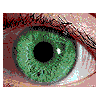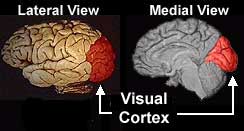 Imagine that when you see a city's skyline, you
taste blackberries. Or maybe when you hear a violin, you feel a tickle on
your left knee. Perhaps you are completely convinced that Wednesdays are
light red. If you have experiences like these, you might have synesthesia. Imagine that when you see a city's skyline, you
taste blackberries. Or maybe when you hear a violin, you feel a tickle on
your left knee. Perhaps you are completely convinced that Wednesdays are
light red. If you have experiences like these, you might have synesthesia.

What is synesthesia?Synesthesia is a condition in which one sense
(for example, hearing) is simultaneously perceived as if by one or more
additional senses such as sight. Another form of synesthesia joins objects
such as letters, shapes, numbers or people's names with a sensory
perception such as smell, color or flavor. The word synesthesia comes from
two Greek words, syn (together) and aisthesis (perception).
Therefore, synesthesia literally means "joined perception."
  Synesthesia can involve any of the senses. The most common form,
colored letters and numbers, occurs when someone always
sees a certain color in response to a certain letter of the alphabet or
number. For example, a synesthete (a person with synesthesia) might see
the word "plane" as mint green or the number
"4" as dark brown. There are also synesthetes
who hear sounds in response to smell, who smell in response to touch, or
who feel something in response to sight. Just about any combination of the
senses is possible. There are some people who possess synesthesia
involving three or even more senses, but this is extremely rare.
Synesthesia can involve any of the senses. The most common form,
colored letters and numbers, occurs when someone always
sees a certain color in response to a certain letter of the alphabet or
number. For example, a synesthete (a person with synesthesia) might see
the word "plane" as mint green or the number
"4" as dark brown. There are also synesthetes
who hear sounds in response to smell, who smell in response to touch, or
who feel something in response to sight. Just about any combination of the
senses is possible. There are some people who possess synesthesia
involving three or even more senses, but this is extremely rare.
Synesthetic perceptions are specific to each person. Different people
with synesthesia almost always disagree on their perceptions. In other
words, if one synesthete thinks that the letter "q" is colored blue, another synesthete might see
"q" as orange.

Although there is no officially
established method of diagnosing synesthesia, some guidelines have been
developed by Richard Cytowic, MD, a leading synesthesia researcher. Not
everyone agrees on these standards, but they provide a starting point for
diagnosis. According to Cytowic, synesthetic perceptions are:
-
 Involuntary: synesthetes do not actively think about
their perceptions; they just happen.
Involuntary: synesthetes do not actively think about
their perceptions; they just happen.
-
 Projected: rather than experiencing something in the
"mind's eye," as might happen when you are asked to imagine a color, a
synesthete often actually sees a color projected outside of the body.
Projected: rather than experiencing something in the
"mind's eye," as might happen when you are asked to imagine a color, a
synesthete often actually sees a color projected outside of the body.
-
 Durable and
generic: the perception must be the same every time; for
example, if you taste chocolate when you hear Beethoven's Violin
Concerto, you must always taste chocolate when you hear it; also, the
perception must be generic -- that is, you may see colors or lines or
shapes in response to a certain smell, but you would not see something
complex such as a room with people and furniture and pictures on the
wall. Durable and
generic: the perception must be the same every time; for
example, if you taste chocolate when you hear Beethoven's Violin
Concerto, you must always taste chocolate when you hear it; also, the
perception must be generic -- that is, you may see colors or lines or
shapes in response to a certain smell, but you would not see something
complex such as a room with people and furniture and pictures on the
wall.
-
 Memorable: often, the secondary synesthetic perception
is remembered better than the primary perception; for example, a
synesthete who always associates the color purple with the name "Laura" will often remember that a woman's name is
purple rather than actually remembering "Laura."
Memorable: often, the secondary synesthetic perception
is remembered better than the primary perception; for example, a
synesthete who always associates the color purple with the name "Laura" will often remember that a woman's name is
purple rather than actually remembering "Laura."
-
 Emotional: the perceptions may cause emotional
reactions such as pleasurable feelings.
Emotional: the perceptions may cause emotional
reactions such as pleasurable feelings.
Who has it? Estimates
for the number of people with synesthesia range from 1 in 200 to 1 in
100,000. There are probably many people who have the condition but do not
realize what it is. Estimates
for the number of people with synesthesia range from 1 in 200 to 1 in
100,000. There are probably many people who have the condition but do not
realize what it is.
Synesthetes tend to be:
-
 Women: in
the U.S., studies show that three times as many women as men have
synesthesia; in the U.K., eight times as many women have been reported
to have it. The reason for this difference is not known. Women: in
the U.S., studies show that three times as many women as men have
synesthesia; in the U.K., eight times as many women have been reported
to have it. The reason for this difference is not known.
-
 Left-handed: synesthetes are more likely to be
left-handed than the general population.
Left-handed: synesthetes are more likely to be
left-handed than the general population.
-
 Neurologically
normal: synesthetes are of normal (or possibly above average)
intelligence, and standard neurological exams are normal. Neurologically
normal: synesthetes are of normal (or possibly above average)
intelligence, and standard neurological exams are normal.
-
 In the same
family: synesthesia appears to be inherited in some fashion; it
seems to be a dominant trait and it may be on the X-chromosome. In the same
family: synesthesia appears to be inherited in some fashion; it
seems to be a dominant trait and it may be on the X-chromosome.
Some celebrated people who may have
had synesthesia include:

-
 Vasily Kandinsky (painter,
1866-1944) Vasily Kandinsky (painter,
1866-1944)
-
 Olivier Messiaen (composer,
1908-1992) Olivier Messiaen (composer,
1908-1992)
-
 Charles Baudelaire (poet,
1821-1867) Charles Baudelaire (poet,
1821-1867)
-
 Franz Liszt (composer,
1811-1886) Franz Liszt (composer,
1811-1886)
-
 Arthur Rimbaud (poet,
1854-1891) Arthur Rimbaud (poet,
1854-1891)
-
 Richard Phillips Feynman
(physicist, 1918-1988) Richard Phillips Feynman
(physicist, 1918-1988)
It is possible that some of these people merely expressed synesthetic
ideas in their arts, although some of them undoubtedly did have
synesthesia.
The Biological Basis of SynesthesiaSome
scientists believe that synesthesia results from "crossed-wiring" in the
brain. They hypothesize that in synesthetes, neurons and synapses that are
"supposed" to be contained within one sensory system cross to another
sensory system. It is unclear why this might happen but some researchers
believe that these crossed connections are present in everyone at birth,
and only later are the connections refined. In some studies, infants
respond to sensory stimuli in a way that researchers think may involve
synesthetic perceptions. It is hypothesized by these researchers that many
children have crossed connections and later lose them. Adult synesthetes
may have simply retained these crossed connections.
 It is unclear which parts of the brain are involved
in synesthesia. Richard Cytowic's research has led him to believe that the
limbic
system is primarily responsible for synesthetic experiences. The
limbic system includes several brain structures primarily
responsible for regulating our emotional responses. Other research,
however, has shown significant activity in the cerebral
cortex during synesthetic experiences. In fact, studies have
shown a particularly interesting effect in the cortex: colored-hearing
synesthetes have been shown to display activity in several areas of the
visual cortex when they hear certain words. In particular, areas of
the visual cortex associated with processing color are activated when the
synesthetes hear words. Non-synesthetes do not show activity in these
areas, even when asked to imagine colors or to associate certain colors
with certain words. It is unclear which parts of the brain are involved
in synesthesia. Richard Cytowic's research has led him to believe that the
limbic
system is primarily responsible for synesthetic experiences. The
limbic system includes several brain structures primarily
responsible for regulating our emotional responses. Other research,
however, has shown significant activity in the cerebral
cortex during synesthetic experiences. In fact, studies have
shown a particularly interesting effect in the cortex: colored-hearing
synesthetes have been shown to display activity in several areas of the
visual cortex when they hear certain words. In particular, areas of
the visual cortex associated with processing color are activated when the
synesthetes hear words. Non-synesthetes do not show activity in these
areas, even when asked to imagine colors or to associate certain colors
with certain words.
Synesthesia and the Study of ConsciousnessMany researchers are
interested in synesthesia because it may reveal something about human
consciousness. One of the biggest mysteries in the study of consciousness
is what is called the "binding problem." No one knows how we bind all of
our perceptions together into one complete whole. For example, when you
hold a flower, you see the colors, you see its shape, you smell its scent,
and you feel its texture. Your brain manages to bind all of these
perceptions together into one concept of a flower. Synesthetes might have
additional perceptions that add to their concept of a flower. Studying
these perceptions may someday help us understand how we perceive our
world. |




 Hear IT!
Hear IT!

 References and more
information on synesthesia, see:
References and more
information on synesthesia, see:
![[email]](Synesthesia_files/menue.gif)



